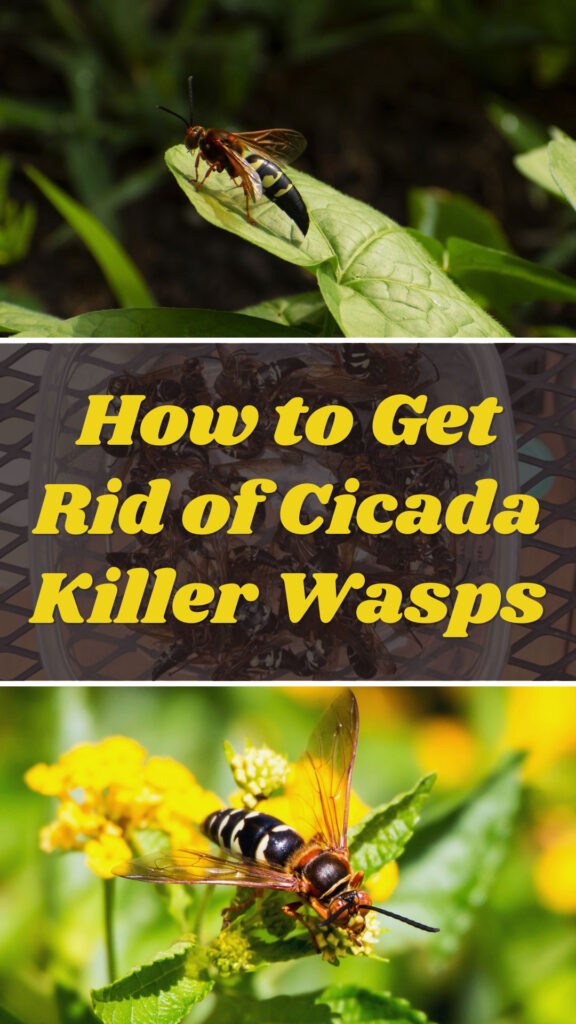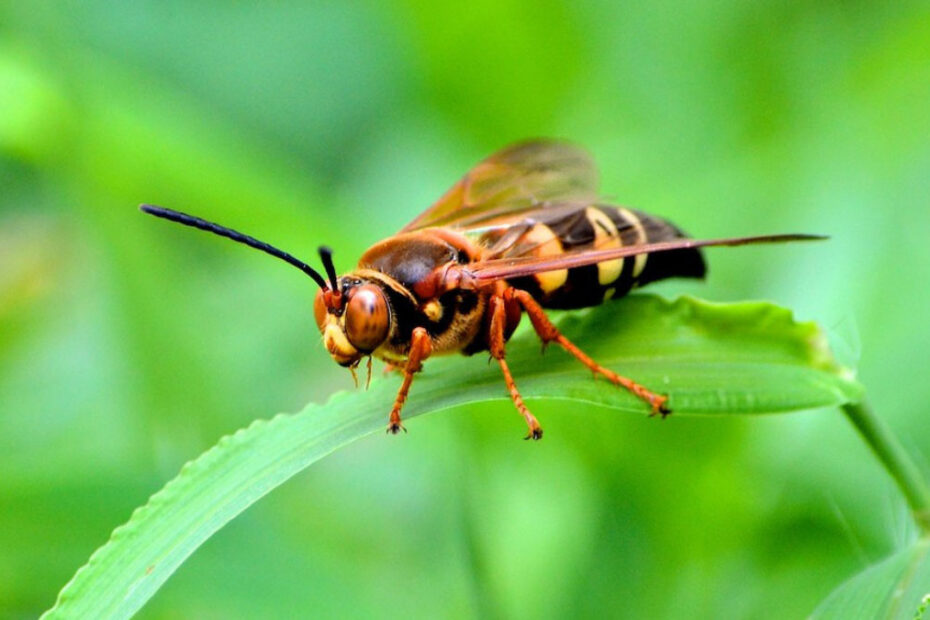If you’re dealing with the buzzing menace of cicada killer wasps in your yard, you’re not alone. These large, intimidating insects can make even the bravest homeowner think twice before stepping outside. While they rarely sting humans, their sheer size and aggressive behavior can be quite unsettling.
Understanding how to effectively get rid of cicada killer wasps requires a strategic approach. From identifying their nests to using safe and effective removal methods, you’ll need a plan that ensures your yard remains a safe and enjoyable space. Let’s jump into the most effective ways to tackle this problem and reclaim your outdoor area.
Key Takeaways
- Effective Identification: Identifying cicada killer wasps through their distinct physical characteristics and behaviors is crucial for determining the best control measures.
- Natural Predators and Ecological Role: Understanding the wasps’ predators and their ecological benefits can help in making informed decisions about management.
- Preventive Measures: Maintaining your yard with regular mowing, soil management, and the use of natural repellents can deter these wasps from nesting.
- Safe Removal Techniques: Both DIY methods and professional pest control services offer safe and effective options for managing cicada killer wasp infestations.

Understanding Cicada Killer Wasps
Cicada killer wasps, also known as Sphecius speciosus, are a fascinating yet intimidating insect species. These wasps are known for their large size and distinctive behavior, which often causes concern among homeowners.
Characteristics
- Physical Appearance: Cicada killer wasps grow up to 2 inches long. They have a reddish-brown body with yellow bands, giving them a striking appearance.
- Habitat: You’ll usually find them in well-drained, sandy, or loose soil regions. They prefer sunny locations such as lawns, gardens, and golf courses.
- Behavior: Females dig extensive burrows to lay their eggs. These burrows can be 10 to 20 inches deep and up to several feet long.
- Diet: While adult cicada killer wasps feed on nectar and sap, their larvae feed on paralyzed cicadas provided by the females.
Lifecycle
- Mating: Mating occurs in mid to late summer. Males establish territories and aggressively defend them.
- Nest Construction: Females dig burrows to create nests where they will lay their eggs.
- Provisioning: A female captures and paralyzes a cicada, brings it back to the nest, and places it in a cell. She then lays an egg on it, providing a food source for the developing larva.
- Development: Eggs hatch in a few days, and larvae feed on cicadas. They overwinter in their burrows and emerge as adults in the following summer.
Human Interactions
- Stinging: Contrary to popular belief, cicada killer wasps rarely sting humans. They sting only when handled or threatened.
- Nesting Sites: Females prefer bare soil patches for nesting, which can be unattractive and disruptive in well-maintained lawns and gardens.
- Control Measures: If you find nests in unwanted areas, you can control them using insecticidal dust and soil treatments or by contacting professional pest control services.
Observational Advantages
Understanding these wasps offers several benefits:
- Ecological Role: Cicada killer wasps play a critical role in controlling cicada populations, which can be beneficial for your garden.
- Educational Opportunities: These wasps offer an excellent opportunity to observe complex insect behavior and lifecycles, benefiting students and nature enthusiasts.
Recognizing the significant attributes and roles of cicada killer wasps can ensure you approach their management effectively without unnecessary fear.
Identifying Cicada Killer Wasps
Identifying cicada killer wasps is crucial to addressing infestations effectively. Recognizing their distinct physical and behavioral characteristics helps you decide the best control measures.
Physical Characteristics
Cicada killer wasps are notably large and unique in appearance.
- Size: Adult wasps can grow up to 2 inches long.
- Color: They have a reddish-brown body with yellow bands across the abdomen.
- Wings: Their wings are transparent with a slight amber tint.
- Head: They possess large, rounded heads with robust mandibles.
- Legs: Their legs are notably strong and adapted for digging.
Behavioral Traits
Understanding the behavior of cicada killer wasps aids in identifying and managing them.
- Nesting: Females dig extensive burrows in well-drained, sandy soil.
- Activity Period: They are most active during the daytime in midsummer when cicadas are prevalent.
- Diet: Adults primarily feed on nectar, while females hunt and paralyze cicadas to provision their nests.
- Aggression: Though intimidating in size, they rarely sting humans unless provoked.
- Ecological Role: They play a crucial role in controlling cicada populations.
Recognizing these physical traits and behaviors will help you accurately identify cicada killer wasps and carry out effective control strategies.
Natural Predators And Ecological Role
Cicada killer wasps play a crucial role in the ecosystem, even though their intimidating presence. Understanding their natural predators and ecological contributions helps you make informed decisions about managing them.
Natural Predators
Several species regulate cicada killer wasp populations:
- Birds: Certain birds, like sparrows and flickers, prey on these wasps.
- Mammals: Skunks and raccoons often dig out wasp burrows to consume larvae and adult wasps.
- Insects: Some parasitic wasps lay eggs in cicada killer larvae, eventually killing them.
Ecological Role
Cicada killer wasps benefit the environment in several ways:
- Controlling Cicada Populations: Each female wasp captures and paralyzes multiple cicadas to provision her nest, reducing cicada numbers.
- Aiding Soil Aeration: Their extensive burrowing helps aerate the soil, promoting plant growth.
- Serving as Prey: They are a food source for various predators, maintaining balance in local ecosystems.
By recognizing the natural predators and ecological roles of cicada killer wasps, you can appreciate their place in the environment, making it easier to decide on whether intervention is necessary.
Prevention Methods
Preventing cicada killer wasps from inhabiting your yard can save you time and effort in dealing with infestations later. Implementing preventive measures ensures a safer and more pleasant outdoor environment.
Yard Maintenance
Maintaining your yard properly can deter cicada killer wasps from nesting. These steps can make your yard less attractive to these insects:
- Regular Mowing: Keep your grass short by mowing frequently. Cicada killer wasps prefer undisturbed areas with longer grass.
- Soil Management: Ensure your soil is well-compacted. Loose, sandy soil is ideal for burrowing.
- Watering: Regularly water your lawn and garden. Moist soil is less appealing to wasps looking to dig their nests.
- Debris Removal: Remove any yard debris, such as fallen leaves and branches, that can provide shelter.
- Plant Choice: Avoid planting flowers that attract these wasps. Consider alternative plants that do not appeal to them.
Natural Repellents
Natural repellents offer an environmentally friendly way to keep cicada killer wasps at bay. Below are some effective options:
- Essential Oils: Use oils like peppermint, cinnamon, and eucalyptus. Mix with water and spray around nesting areas.
- Garlic Spray: Crush garlic cloves and mix with water. Spray in problem areas to repel wasps.
- Cucumber Peels: Scatter cucumber peels around your yard. The acidic nature deters wasps.
- Diatomaceous Earth: Sprinkle in potential nesting sites. This natural powder can discourage wasps from settling.
By consistently applying these preventive methods, you can significantly reduce the likelihood of cicada killer wasps choosing your yard as their nesting ground.
Safe Removal Techniques
Safe removal techniques for cicada killer wasps involve both DIY solutions and professional pest control services. Choosing the right method depends on the infestation level and your comfort with handling these insects.
DIY Solutions
Use DIY solutions to manage small infestations while minimizing chemical exposure.
- Identify Nest Locations: First, locate the nests. Look for holes in sandy, well-drained soil.
- Apply Boiling Water: Pour boiling water into the nest entrance early in the morning or late in the evening when wasps are less active.
- Use Soap and Water Solution: Mix two tablespoons of dish soap in a gallon of water. Pour it into the nest entrance to create an inhospitable environment.
- Carry out Physical Barriers: Cover nest entrances with rocks or heavy bricks to prevent wasps from re-entering.
Professional Pest Control Services
Engage professional pest control services for extensive infestations or when DIY methods are insufficient.
- Assessment: Pest control professionals will assess the infestation’s severity and the nest’s location.
- Targeted Treatments: They use insecticidal dust or sprays precisely to ensure effectiveness and safety.
- Follow-Up Visits: Many services include follow-up visits to monitor progress and reapply treatments if necessary.
- Eco-Friendly Options: Some companies offer green pest control methods that minimize environmental impact while effectively removing wasps.
These techniques provide reliable solutions to manage cicada killer wasp infestations, ensuring safety and peace of mind for homeowners.
Conclusion
Effectively managing cicada killer wasps involves a combination of identification, safe removal methods, and preventive measures. By understanding their behavior and ecological role, you can make informed decisions about whether to intervene. Utilizing both DIY solutions and professional pest control services ensures you can reclaim your outdoor spaces without unnecessary risks. Consistent yard maintenance and natural repellents can also help deter these wasps from nesting in your area. With these strategies, you can confidently address cicada killer wasp infestations and enjoy a more peaceful outdoor environment.
Frequently Asked Questions
What are cicada killer wasps?
Cicada killer wasps, also known as Sphecius speciosus, are large wasps that can grow up to 2 inches long. They have a reddish-brown body with yellow bands and prefer well-drained, sandy soils for nesting.
Are cicada killer wasps dangerous to humans?
Despite their large size and aggressive appearance, cicada killer wasps rarely sting humans. Their primary focus is on paralyzing cicadas to provision their nests.
How can I identify a cicada killer wasp?
You can identify cicada killer wasps by their size (up to 2 inches), reddish-brown body with yellow bands, transparent wings, large heads, and strong legs adapted for digging.
Where do cicada killer wasps nest?
Cicada killer wasps prefer well-drained, sandy soils for creating their nests. They dig extensive burrows to lay eggs and store paralyzed cicadas for their larvae.
Do cicada killer wasps benefit the environment?
Yes, cicada killer wasps play an important ecological role by controlling cicada populations and aiding soil aeration through their burrowing activities.
What are natural predators of cicada killer wasps?
Natural predators of cicada killer wasps include birds like sparrows and flickers, as well as mammals such as skunks and raccoons, which help regulate their populations.
How can I prevent cicada killer wasps from nesting in my yard?
To deter cicada killer wasps, maintain your yard through regular mowing, soil management, watering, debris removal, and careful plant selection. Using natural repellents like essential oils and garlic spray can also help.
What are safe ways to remove cicada killer wasps?
For small infestations, homeowners can use boiling water, a soap and water solution, and physical barriers. For larger infestations, professional pest control services can apply targeted treatments and provide follow-up visits.
Do cicada killer wasps play a role in the ecosystem?
Yes, these wasps help control cicada populations and their burrowing aids in soil aeration. They also serve as prey for various predators, contributing to ecological balance.
Should I call a professional to remove cicada killer wasps?
For extensive infestations or if you feel uncomfortable handling the wasps, it is advisable to call a professional pest control service. They can assess the situation and apply effective treatments safely.
